2014 NISSAN 370Z COUPE engine coolant
[x] Cancel search: engine coolantPage 21 of 428
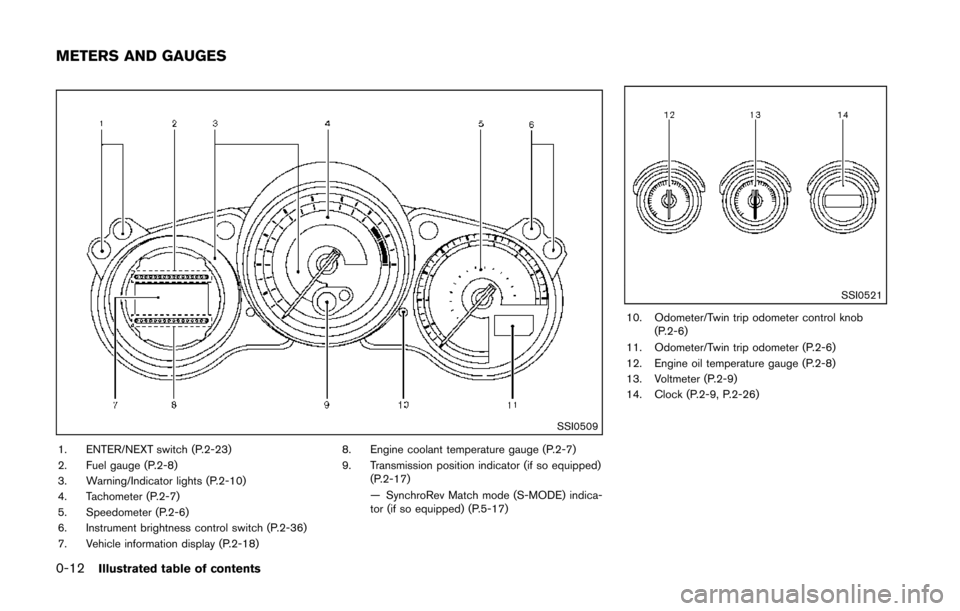
0-12Illustrated table of contents
SSI0509
1. ENTER/NEXT switch (P.2-23)
2. Fuel gauge (P.2-8)
3. Warning/Indicator lights (P.2-10)
4. Tachometer (P.2-7)
5. Speedometer (P.2-6)
6. Instrument brightness control switch (P.2-36)
7. Vehicle information display (P.2-18)8. Engine coolant temperature gauge (P.2-7)
9. Transmission position indicator (if so equipped)
(P.2-17)
— SynchroRev Match mode (S-MODE) indica-
tor (if so equipped) (P.5-17)
SSI0521
10. Odometer/Twin trip odometer control knob(P.2-6)
11. Odometer/Twin trip odometer (P.2-6)
12. Engine oil temperature gauge (P.2-8)
13. Voltmeter (P.2-9)
14. Clock (P.2-9, P.2-26)
METERS AND GAUGES
Page 22 of 428
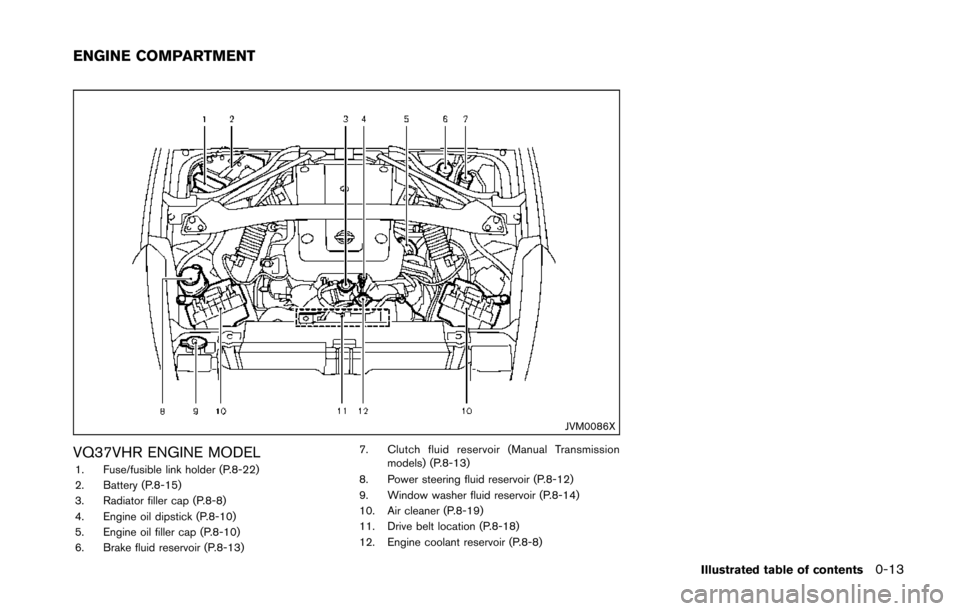
JVM0086X
VQ37VHR ENGINE MODEL1. Fuse/fusible link holder (P.8-22)
2. Battery (P.8-15)
3. Radiator filler cap (P.8-8)
4. Engine oil dipstick (P.8-10)
5. Engine oil filler cap (P.8-10)
6. Brake fluid reservoir (P.8-13)7. Clutch fluid reservoir (Manual Transmission
models) (P.8-13)
8. Power steering fluid reservoir (P.8-12)
9. Window washer fluid reservoir (P.8-14)
10. Air cleaner (P.8-19)
11. Drive belt location (P.8-18)
12. Engine coolant reservoir (P.8-8)
Illustrated table of contents0-13
ENGINE COMPARTMENT
Page 66 of 428
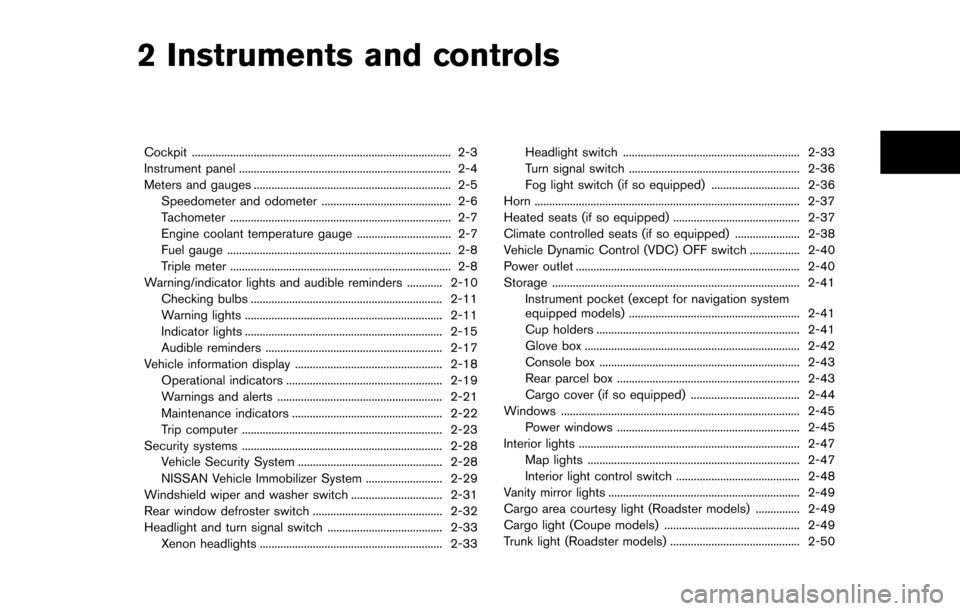
2 Instruments and controls
Cockpit ........................................................................\
................ 2-3
Instrument panel ........................................................................\
2-4
Meters and gauges ................................................................... 2-5
Speedometer and odometer ............................................ 2-6
Tachometer ........................................................................\
... 2-7
Engine coolant temperature gauge ................................ 2-7
Fuel gauge ........................................................................\
.... 2-8
Triple meter ........................................................................\
... 2-8
Warning/indicator lights and audible reminders ............ 2-10 Checking bulbs ................................................................. 2-11
Warning lights ................................................................... 2-11
Indicator lights ................................................................... 2-15
Audible reminders ............................................................ 2-17
Vehicle information display .................................................. 2-18 Operational indicators ..................................................... 2-19
Warnings and alerts ........................................................ 2-21
Maintenance indicators ................................................... 2-22
Trip computer .................................................................... 2-23
Security systems .................................................................... 2-28 Vehicle Security System ................................................. 2-28
NISSAN Vehicle Immobilizer System .......................... 2-29
Windshield wiper and washer switch ............................... 2-31
Rear window defroster switch ............................................ 2-32
Headlight and turn signal switch ....................................... 2-33 Xenon headlights .............................................................. 2-33 Headlight switch ............................................................ 2-33
Turn signal switch .......................................................... 2-36
Fog light switch (if so equipped) .............................. 2-36
Horn ........................................................................\
.................. 2-37
Heated seats (if so equipped) ........................................... 2-37
Climate controlled seats (if so equipped) ...................... 2-38
Vehicle Dynamic Control (VDC) OFF switch ................. 2-40
Power outlet ........................................................................\
.... 2-40
Storage ........................................................................\
............ 2-41 Instrument pocket (except for navigation system
equipped models) .......................................................... 2-41
Cup holders ..................................................................... 2-41
Glove box ........................................................................\
. 2-42
Console box .................................................................... 2-43
Rear parcel box .............................................................. 2-43
Cargo cover (if so equipped) ..................................... 2-44
Windows ........................................................................\
......... 2-45 Power windows .............................................................. 2-45
Interior lights ........................................................................\
... 2-47 Map lights ........................................................................\
2-47
Interior light control switch .......................................... 2-48
Vanity mirror lights ................................................................. 2-49
Cargo area courtesy light (Roadster models) ............... 2-49
Cargo light (Coupe models) .............................................. 2-49
Trunk light (Roadster models) ............................................ 2-50>
Page 70 of 428
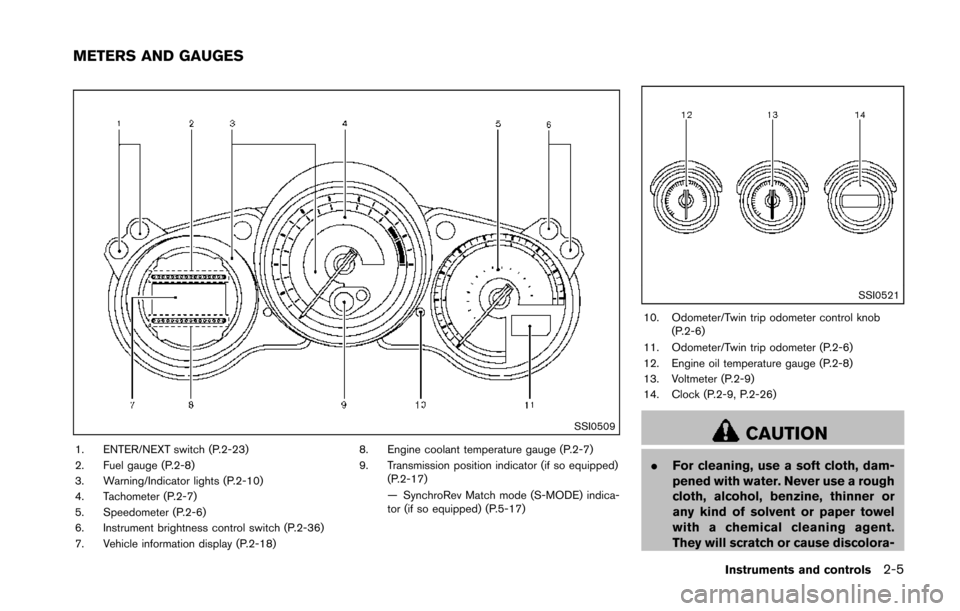
SSI0509
1. ENTER/NEXT switch (P.2-23)
2. Fuel gauge (P.2-8)
3. Warning/Indicator lights (P.2-10)
4. Tachometer (P.2-7)
5. Speedometer (P.2-6)
6. Instrument brightness control switch (P.2-36)
7. Vehicle information display (P.2-18)8. Engine coolant temperature gauge (P.2-7)
9. Transmission position indicator (if so equipped)
(P.2-17)
— SynchroRev Match mode (S-MODE) indica-
tor (if so equipped) (P.5-17)
SSI0521
10. Odometer/Twin trip odometer control knob(P.2-6)
11. Odometer/Twin trip odometer (P.2-6)
12. Engine oil temperature gauge (P.2-8)
13. Voltmeter (P.2-9)
14. Clock (P.2-9, P.2-26)
CAUTION
. For cleaning, use a soft cloth, dam-
pened with water. Never use a rough
cloth, alcohol, benzine, thinner or
any kind of solvent or paper towel
with a chemical cleaning agent.
They will scratch or cause discolora-
Instruments and controls2-5
METERS AND GAUGES
Page 72 of 428
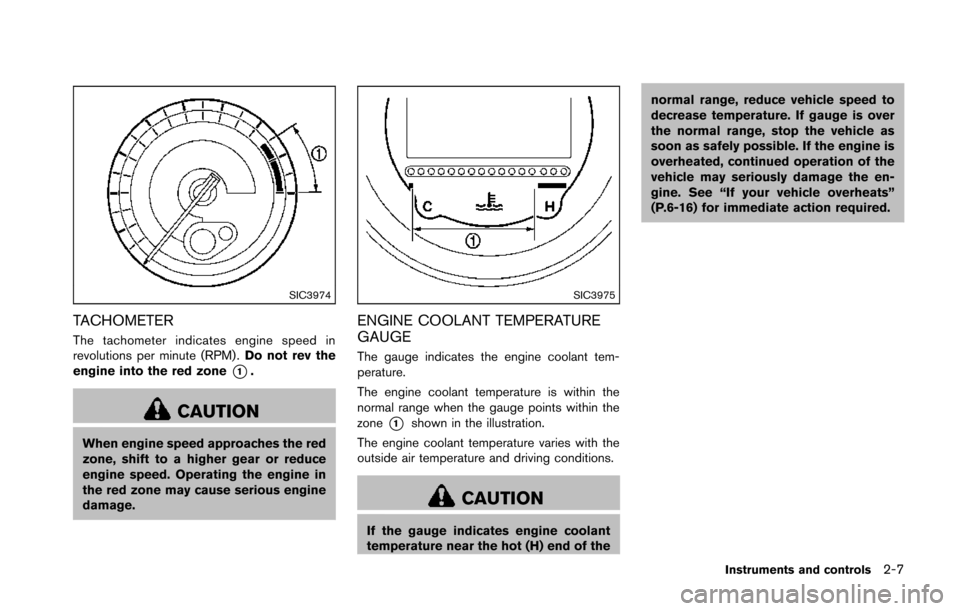
SIC3974
TACHOMETER
The tachometer indicates engine speed in
revolutions per minute (RPM) .Do not rev the
engine into the red zone
*1.
CAUTION
When engine speed approaches the red
zone, shift to a higher gear or reduce
engine speed. Operating the engine in
the red zone may cause serious engine
damage.
SIC3975
ENGINE COOLANT TEMPERATURE
GAUGE
The gauge indicates the engine coolant tem-
perature.
The engine coolant temperature is within the
normal range when the gauge points within the
zone
*1shown in the illustration.
The engine coolant temperature varies with the
outside air temperature and driving conditions.
CAUTION
If the gauge indicates engine coolant
temperature near the hot (H) end of the normal range, reduce vehicle speed to
decrease temperature. If gauge is over
the normal range, stop the vehicle as
soon as safely possible. If the engine is
overheated, continued operation of the
vehicle may seriously damage the en-
gine. See “If your vehicle overheats”
(P.6-16) for immediate action required.
Instruments and controls2-7
Page 191 of 428
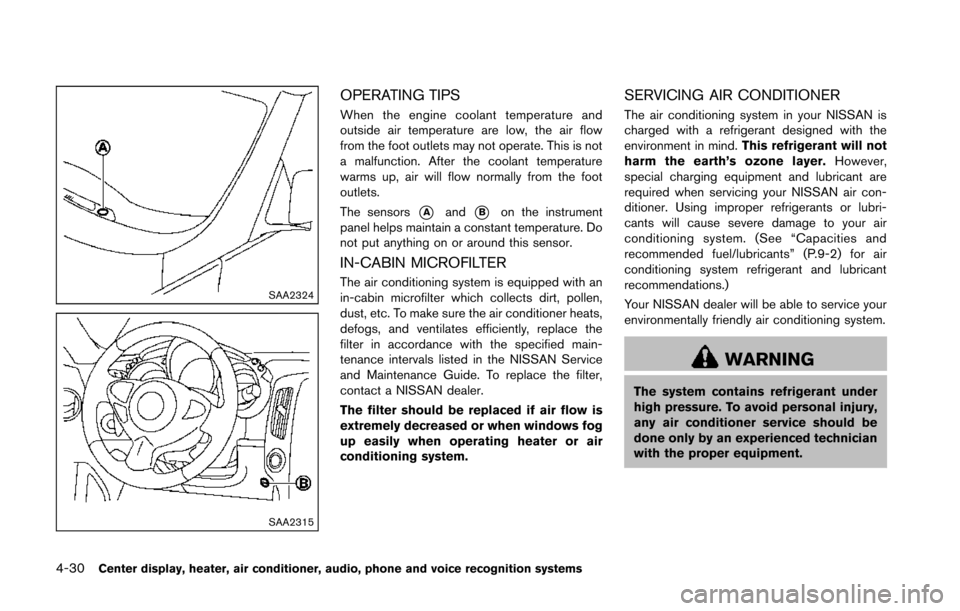
4-30Center display, heater, air conditioner, audio, phone and voice recognition systems
SAA2324
SAA2315
OPERATING TIPS
When the engine coolant temperature and
outside air temperature are low, the air flow
from the foot outlets may not operate. This is not
a malfunction. After the coolant temperature
warms up, air will flow normally from the foot
outlets.
The sensors
*Aand*Bon the instrument
panel helps maintain a constant temperature. Do
not put anything on or around this sensor.
IN-CABIN MICROFILTER
The air conditioning system is equipped with an
in-cabin microfilter which collects dirt, pollen,
dust, etc. To make sure the air conditioner heats,
defogs, and ventilates efficiently, replace the
filter in accordance with the specified main-
tenance intervals listed in the NISSAN Service
and Maintenance Guide. To replace the filter,
contact a NISSAN dealer.
The filter should be replaced if air flow is
extremely decreased or when windows fog
up easily when operating heater or air
conditioning system.
SERVICING AIR CONDITIONER
The air conditioning system in your NISSAN is
charged with a refrigerant designed with the
environment in mind. This refrigerant will not
harm the earth’s ozone layer. However,
special charging equipment and lubricant are
required when servicing your NISSAN air con-
ditioner. Using improper refrigerants or lubri-
cants will cause severe damage to your air
conditioning system. (See “Capacities and
recommended fuel/lubricants” (P.9-2) for air
conditioning system refrigerant and lubricant
recommendations.)
Your NISSAN dealer will be able to service your
environmentally friendly air conditioning system.
WARNING
The system contains refrigerant under
high pressure. To avoid personal injury,
any air conditioner service should be
done only by an experienced technician
with the proper equipment.
Page 288 of 428
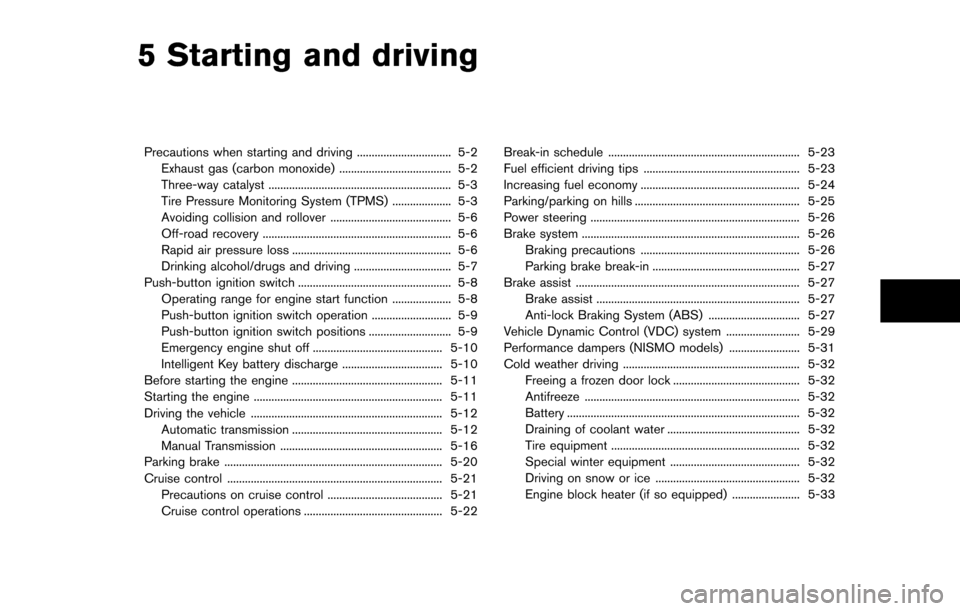
5 Starting and driving
Precautions when starting and driving ................................ 5-2Exhaust gas (carbon monoxide) ...................................... 5-2
Three-way catalyst .............................................................. 5-3
Tire Pressure Monitoring System (TPMS) .................... 5-3
Avoiding collision and rollover ......................................... 5-6
Off-road recovery ................................................................ 5-6
Rapid air pressure loss ...................................................... 5-6
Drinking alcohol/drugs and driving ................................. 5-7
Push-button ignition switch .................................................... 5-8 Operating range for engine start function .................... 5-8
Push-button ignition switch operation ........................... 5-9
Push-button ignition switch positions ............................ 5-9
Emergency engine shut off ............................................ 5-10
Intelligent Key battery discharge .................................. 5-10
Before starting the engine ................................................... 5-11
Starting the engine ................................................................ 5-11
Driving the vehicle ................................................................. 5-12 Automatic transmission ................................................... 5-12
Manual Transmission ....................................................... 5-16
Parking brake ........................................................................\
.. 5-20
Cruise control ........................................................................\
. 5-21 Precautions on cruise control ....................................... 5-21
Cruise control operations ............................................... 5-22 Break-in schedule ................................................................. 5-23
Fuel efficient driving tips ..................................................... 5-23
Increasing fuel economy ...................................................... 5-24
Parking/parking on hills ........................................................ 5-25
Power steering ....................................................................... 5-26
Brake system ........................................................................\
.. 5-26
Braking precautions ...................................................... 5-26
Parking brake break-in .................................................. 5-27
Brake assist ........................................................................\
.... 5-27 Brake assist ..................................................................... 5-27
Anti-lock Braking System (ABS) ............................... 5-27
Vehicle Dynamic Control (VDC) system ......................... 5-29
Performance dampers (NISMO models) ........................ 5-31
Cold weather driving ............................................................ 5-32 Freeing a frozen door lock ........................................... 5-32
Antifreeze ........................................................................\
. 5-32
Battery ........................................................................\
....... 5-32
Draining of coolant water ............................................. 5-32
Tire equipment ................................................................ 5-32
Special winter equipment ............................................ 5-32
Driving on snow or ice ................................................. 5-32
Engine block heater (if so equipped) ....................... 5-33
Page 304 of 428
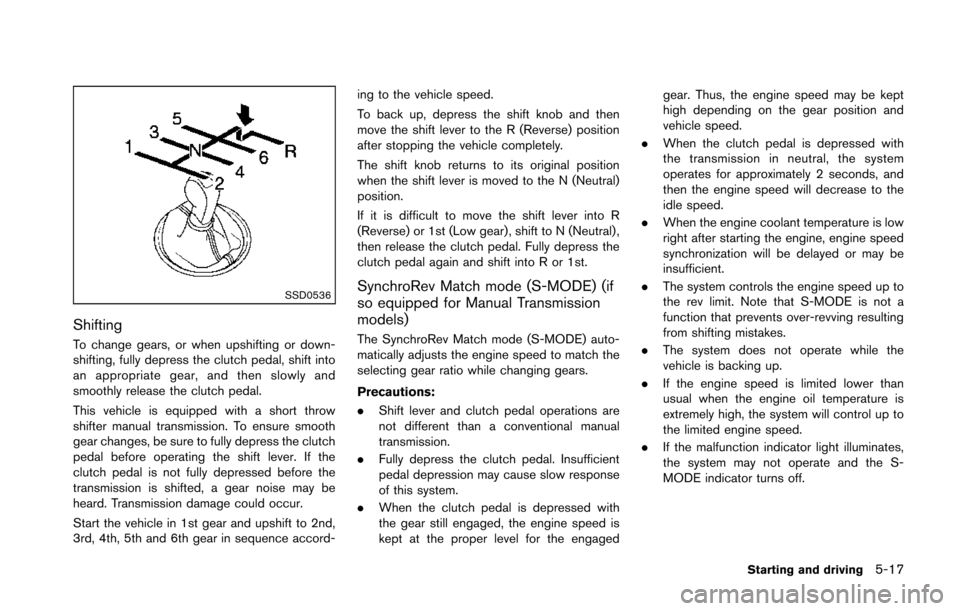
SSD0536
Shifting
To change gears, or when upshifting or down-
shifting, fully depress the clutch pedal, shift into
an appropriate gear, and then slowly and
smoothly release the clutch pedal.
This vehicle is equipped with a short throw
shifter manual transmission. To ensure smooth
gear changes, be sure to fully depress the clutch
pedal before operating the shift lever. If the
clutch pedal is not fully depressed before the
transmission is shifted, a gear noise may be
heard. Transmission damage could occur.
Start the vehicle in 1st gear and upshift to 2nd,
3rd, 4th, 5th and 6th gear in sequence accord-ing to the vehicle speed.
To back up, depress the shift knob and then
move the shift lever to the R (Reverse) position
after stopping the vehicle completely.
The shift knob returns to its original position
when the shift lever is moved to the N (Neutral)
position.
If it is difficult to move the shift lever into R
(Reverse) or 1st (Low gear), shift to N (Neutral) ,
then release the clutch pedal. Fully depress the
clutch pedal again and shift into R or 1st.
SynchroRev Match mode (S-MODE) (if
so equipped for Manual Transmission
models)
The SynchroRev Match mode (S-MODE) auto-
matically adjusts the engine speed to match the
selecting gear ratio while changing gears.
Precautions:
.
Shift lever and clutch pedal operations are
not different than a conventional manual
transmission.
. Fully depress the clutch pedal. Insufficient
pedal depression may cause slow response
of this system.
. When the clutch pedal is depressed with
the gear still engaged, the engine speed is
kept at the proper level for the engaged gear. Thus, the engine speed may be kept
high depending on the gear position and
vehicle speed.
. When the clutch pedal is depressed with
the transmission in neutral, the system
operates for approximately 2 seconds, and
then the engine speed will decrease to the
idle speed.
. When the engine coolant temperature is low
right after starting the engine, engine speed
synchronization will be delayed or may be
insufficient.
. The system controls the engine speed up to
the rev limit. Note that S-MODE is not a
function that prevents over-revving resulting
from shifting mistakes.
. The system does not operate while the
vehicle is backing up.
. If the engine speed is limited lower than
usual when the engine oil temperature is
extremely high, the system will control up to
the limited engine speed.
. If the malfunction indicator light illuminates,
the system may not operate and the S-
MODE indicator turns off.
Starting and driving5-17